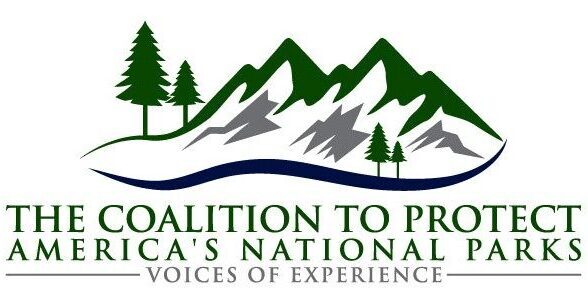
By Kurt Repanshek
October 7, 2025
National parks across the country might appear to be operating largely as usual during the government shutdown, but natural and cultural resources are at risk, National Park Service morale is further being crushed, and family finances are at risk while many politicians look the other way, former agency personnel said Tuesday.
“The [Trump] administration is threatening imminent mass layoffs during the shutdown, as well as potential loss of back pay while these employees are forced to be on furlough,” said Sue Fritzke, a member of the Coalition to Protect America’s National Parks who spent nearly four decades working for the Park Service. “These hardworking employees, who are already unsure when they will see their next paycheck, now fear losing their jobs entirely. At the same time, parks are required to uphold a facade of normal operations to the public, per [Interior] Secretary [Doug] Burgum’s order that parks remain open and accessible.”
The conference call with reporters, held as the shutdown entered its seventh day with no end in sight, offered up a summation of how the Trump administration and Republicans in Congress, through their acquiescence, have run roughshod over the Park Service and other public lands agencies.
Since Trump entered his second term in office on January 20 the president initially blocked the hiring of seasonal employees; fired more than a thousand probationary Park Service employees on Valentine’s Day, a move that later was reversed, and; encouraged federal employees to retire early and continue to receive pay through the end of Fiscal 2025, which was September 30.
The various steps have seen nearly one-quarter of the Park Service workforce depart, according to the National Parks Conservation Association. Now, with the government shut down, the administration has indicated that more firings could be coming, and that those employees currently furloughed might not receive backpay once Congress comes to agreement on the federal budget.
Scott Fitzwilliams, the U.S. Forest Service’s forest supervisor for the White River National Forest in Colorado, said he took the early retirement package offered earlier this year rather than try to stomach the orders he was being given.
“I had to fire 16 employees in the forest and issue them a letter that said their performance was bad,” said Fitzwilliams during the Zoom call. “And it just struck me: I can’t work in this environment. You know, we’re a month into the new administration, and they’re telling us to lie to our employees and fire them for no reason.”
The speakers, which also included Bob Krumenaker, a Park Service veteran of four decades; Dale Sexton, owner of a fly fishing shop in Livingston, Montana, and; Emily Thompson, executive director of the Coalition to Protect America’s National Parks, spoke of the risks to park and forest resources, as well as to visitors and hunters, at a time when few rangers were on duty.
They pointed to businesses, such as ski resorts that operate on Forest Service lands, as being placed in economic risk because required environmental studies tied to new projects are in limbo due to staffing cuts; federal lands employees, both those deemed essential and still working and those furloughed, being placed in financial jeopardy, and; the ever-present risk of vandalism to the parks and forests.
Also voiced was the concern that the Trump administration, by keeping parks open, might be trying to show that the Park Service is not needed to operate them.
Federal employees are “pawns in a political fight not of their making,” Krumenaker said. “Most of these employees are furloughed. They’re kept from doing the work they were hired to do. Others are required to work to serve the administration’s objective to keep up that facade that everything is normal, and perhaps that we don’t need the NPS at all.
“None of them are getting paid and won’t until the shutdown ends, presuming the administration will actually comply with existing law requiring that
furloughed employees do receive back pay,” he added.
Fitzwilliams, who has done similar news conferences this year and wears his concerns in his voice and facial expressions, lamented what’s at risk over the political stalemate in Congress and the administration’s desires to shrink the federal workforce and open up public lands to mining and energy development.”
“Our public land system is one of the greatest experiments of democracy. You know, nowhere else in the world — it’s a uniquely American ideal, nowhere else in the world did a country set aside millions — hundreds of millions — of acres to be managed in the public trust, owned by everyone, and available for so many different things,” he said. “It’s just this broad spectrum of parks and refuges and Forest Service lands and BLM lands that have such an incredible amount of opportunity, both economically and for people.
“To sit and watch what I have seen the last seven, eight months of a deliberate dismantling of these lands has been tough,” said Fitzwilliams, who worried that “the next generation or two may not enjoy what we have for over 125, 130 years. It’s deliberate, and it’s through budget cuts, staffing reductions you’ve heard about, and an overall sense of fear that most employees are working under right now.”
Sexton, whose livelihood hinges greatly on clean and healthy rivers and streams throughout the Greater Yellowstone Ecosystem, qualified his hope that the current events would not be inject long-lasting impacts on the parks and forests and their managing agencies.
“I take respite knowing that our national parks are incredibly beloved, and respected, and enduring,” he said, adding, though, that “I take faith that Montana’s congressional delegation and our senators are staunch supporters of the parks. However, I’m concerned that their bending of the knee, if you will, to our president may usurp their devotion to our parks.”
